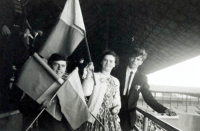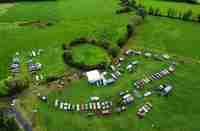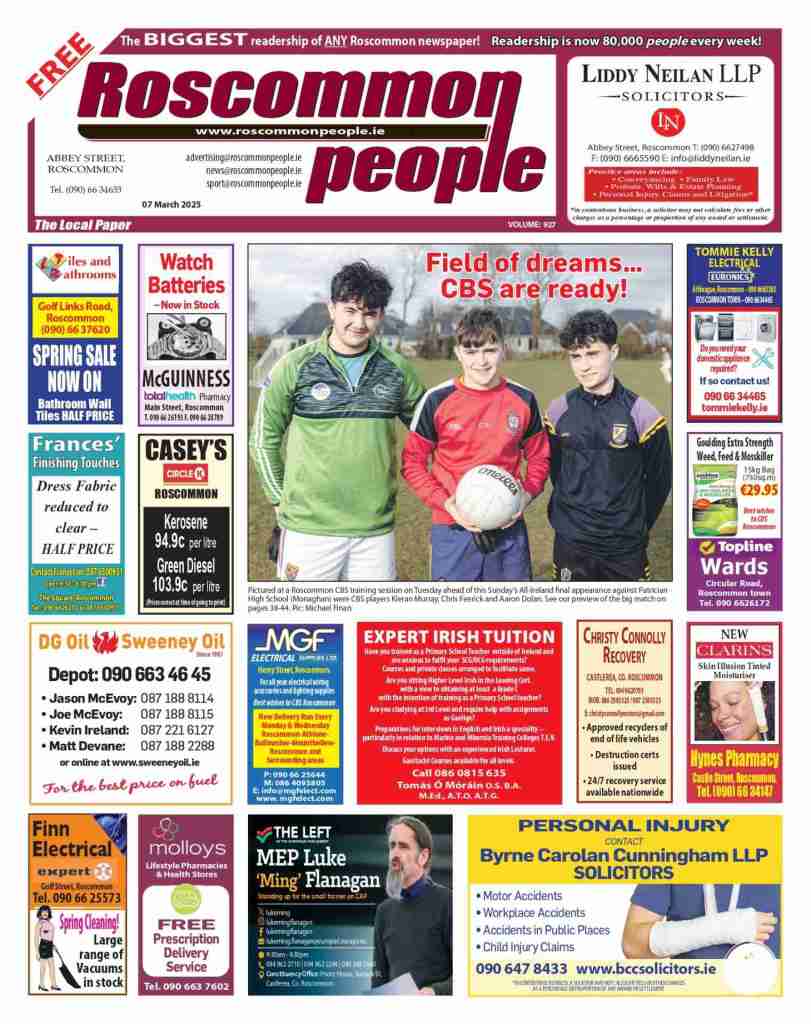SPECIAL REPORT
Gentle giant
Reynolds’ pub, invitingly positioned across the bridge, has long been a landmark premises on the edge of Rooskey village. For a long time, it was ‘The Widow’s’, so-called when Peter Reynolds’ late mother, Elizabeth, presided there (from 1961 into the late 1980s). Nowadays, for decades by now, Peter and Marian and their family run the bar. Reynolds’ – like the village’s other pubs – takes us through prosperous times, recessions, life, death and everything in between.
I’d occasionally meet Liam Farrell there. He only ever seemed to have a couple of pints, not being a big drinker at all. The bar counter in Peter’s, as in most country pubs, tended to be the domain of men of a certain age. They were usually farmers, but not always. Then again, even those who weren’t farmers probably dabbled a bit in the land.
At different times of year, there was an influx of English anglers. They loved the village, marvelling at the atmosphere in Reynolds’ bar. In summertime, tourists from various countries in mainland Europe would call in, taking a break from spending the evening on one of the many cruisers berthed beside Rooskey bridge.
On many nights, the bar counter would be the jurisdiction, at least for an hour or so, of five or six locals, usually men. Their focus almost always seemed to be on the past, on happy memories, on stories worth retelling, yarns and characters recalled.
Liam Farrell was a hard worker all his life… on his farm, and in Hanley’s factory, where he was very popular. An hour in the pub was all about social interaction for him. He and my late father were friendly. Very friendly in fact; as the 21st century took hold, they became elder statesmen of the village. When I was in their company, what I noticed about Liam – what everyone noticed – was how he carried himself, how he conducted himself. He was always, without fail, a dapper dresser. He was unfailingly polite. He had a great smile. He was courteous, humble, easygoing, by nature unruffled.
I am pretty sure I never heard him swear even once. He just didn’t do it. This trait seemed to go against logic. A big, handsome, distinguished man, a man of the land, he just didn’t swear… or say a bad word about anybody.
This is how he was. It’s why everyone in Rooskey thought ‘Gentle giant’ and ‘One of nature’s gentlemen’ when Liam Farrell appeared in a room, or if his name came up.
Last Sunday
The people of Rooskey were there for the Farrell family last Sunday. It was an unusual occasion, draped in deep sadness, but with space for hope to peer through.
For all the changes in the village over recent decades – cultural, imagined, actual – Rooskey remains a close-knit village. This is a beautiful part of the country. It’s my own neck of the woods. I grew up there. I think of it as being ‘Roscommon’, but Leitrim quite rightly has a claim too, at least to an extent.
The Farrell residence is at Aughamore, on the Longford Road, across the bridge, up from those charming adjoining pubs, Reynolds’ and The Weir Lodge.
Last Sunday, a big crowd gathered. The people were there to show solidarity with the Farrell family, five years (to the day) on from their father’s mysterious death.
Yes, Consultant Pathologist Professor Paul Hartel concluded some time ago that Liam Farrell’s death in January 2020 was as a result of a heart attack. But questions that persisted for the family then have now morphed into a conviction that something untoward, violent and criminal happened the night their father died. It feels as though there are now more unanswered questions than ever. So much so that the Garda Commissioner recently bowed to pressure and agreed to instigate a review into the original Garda investigation.
Outside the wall of the garden of the home in which he grew up, Brendan Farrell welcomed the family’s neighbours, friends, and the significant media presence. He called on his brother, Peter, to address the attendance. Moments later, Peter unveiled a plaque commemorating their late Dad, which also serves as a ‘prompter’ for anyone with information to contact the Gardaí.
Chatting to locals, I quickly gauged the mood of the community. They had listened in respectful silence as Fr Seamus O’Rourke, then Brendan Farrell, then Peter, spoke. Now, the formalities over, people broke into small groups, offering support to the Farrell family, chatting too about what brought us together.
It was easy to gauge the mood of locals on Sunday. Every single person I spoke to expressed concern over those unanswered questions. MEP Ciaran Mullooly, Deputy Martin Kenny, Senator Eugene Murphy and Cllr Sean McGowan were amongst the prominent figures present. There was a real sense of a community at one with a family that’s hurting. A clear sense of a community that’s uneasy, at very best. People believe that the death of Liam Farrell is suspicious, that he may well have been attacked on the night he died. That his death must be fully investigated again. That his family, and his community, need answers. And justice.
What we know
On Saturday night, 11th of January 2020, Liam Farrell followed his usual weekend routine. The 87-year-old farmer, who lived on his own a few hundred yards up the road, set off for Reynolds’ pub. It’s a walk that took him five or six minutes. It was a familiar walk for Liam, a widower since the death of his wife, Maureen.
Publican Peter Reynolds recalls that Liam was in his usual good form that night. After a while – again following routine – Liam moved next door to The Weir Lodge where again he was said to be in good spirits.
He left The Weir Lodge at around ten past midnight, waved at a local taxi driver, then began walking towards his home, where his beloved dog (Marley) was waiting. Mystery surrounds what happened next. Approximately 15 hours later, at 3.30 pm on the Sunday, Liam’s daughter, Ann, called to check on her Dad. She found him slumped on the ground outside the back door of the house. His shoes and socks were missing. He was “covered in blood”. He had bruises on his body. His watch was missing. This appeared to have all the hallmarks of an assault, an attempted burglary perhaps. Liam’s family now claim that he was beaten and tied up in his hayshed, before being dragged to the back of the house.
When Gardaí were called, they declared the site a crime scene. Liam Farrell could not be revived. His body was taken to Sligo Hospital for a post-mortem.
His family were distraught, the community shocked. The popular local man was laid to rest the following Thursday in Cloonmorris Cemetery, after Funeral Mass in St Michael’s Church in Bornacoola.
A Garda investigation into the circumstances of his death resulted in a file being submitted to the Office of the Director of Public Prosecutions. But no prosecution was recommended.
Questions, opinions
It’s been a horrendous ordeal for the family. Liam’s son, Brendan, has led a campaign for the justice they believe has been denied. Five years have passed. Five years, both long and short. The unanswered questions loom large.
Anne Vaughan, of The Weir Lodge, noted that an unfamiliar man was seen speaking to Mr Farrell in the pub on the night he died. Did that person approach the farmer after he left the pub?
Why were Mr Farrell’s shoes and socks removed? Why was his watch missing? How did the bruising happen?
Brendan Farrell has consistently expressed a belief that his father was attacked.
Last September, an inquest into Liam Farrell’s death was held at Carrick-on-Shannon Coroner’s Court. Professor Hartel, who previously concluded that the Rooskey man had died due to a heart attack, now says if he’d known that Mr Farrell had been discovered under suspicious circumstances or that a crime scene had been established, he would have declined to perform the autopsy, as such cases require a forensic pathologist.
Chief State Pathologist Dr Linda Mulligan, on reviewing Professor Hartel’s report, outlined two possible scenarios: Mr Farrell either suffered a heart attack, fell, and sustained injuries in the process, or another party was involved, triggering a stress-induced heart attack. According to Dr Mulligan, the injuries incurred were consistent with both possibilities.
Dr Mulligan stated that the involvement of another person could not be ruled out entirely.
Professor Jack Crane, former State Pathologist for Northern Ireland (who was hired by the Farrell family), suggested that Mr Farrell’s injuries were consistent with an assault. His view was that Mr Farrell had likely been confronted by an intruder outside his home, struck in the face, and (then) attempted to make his way back inside. He described an eye injury sustained by Mr Farrell as being typical of blunt force trauma.
The inquest into Liam Farrell’s death recorded an ‘open verdict’, which can be taken to mean that the evidence did not fully or clearly explain the cause and circumstances of death.
‘Betrayed’
At the plaque unveiling last Sunday, new claims emerged. Unexpectedly, the text on the plaque states that Liam Farrell was “brutally attacked behind his house and in the hayshed”… “where he was tied with a rope and severely beaten”.
It adds: “He was subsequently dragged from the hayshed to the back door of the house…”
The text continues: “Our father lay dying outside the back door in the coldest of winter conditions before finally passing away some 15 hours later”.
Peter Farrell says there is photographic evidence to back up these assertions. (Blood was discovered in the hayshed last September by a private forensics team which was engaged by the family).
There is a dramatic further claim on the plaque: “We believe our father was betrayed by persons close to him and continues to be by the deafening silence of those who know the truth”.
The direct language begs the question: Are there people in the locality who have information that should be immediately conveyed to An Garda Síochána?
What now?
Following the inquest in September, and with pressure mounting, the Garda Commissioner, Drew Harris, directed a senior officer of An Garda Síochána to conduct a peer review of the original investigation. That officer has already engaged with the family, and listened to their views. Brendan Farrell says that the review now being carried out has the scope to follow any new leads that might arise.
The family believes that there are persons in the community who could provide such vital leads. They talk of previously volunteered information having (allegedly) been retracted, hinting at silence where there should be sharing. They believe their father was viciously assaulted, and are appealing for people to help ease their pain.
Last Sunday, both Brendan and Peter Farrell appealed to anyone with information concerning their father’s death to contact the Garda Confidential Line on 1800 666 111.
Goodness
There was an air of decency about this man that was striking… an air of family values, of goodness, a quiet charisma too. A daily Mass-goer, he was a humble man of great faith.
Last Sunday, Eoghan Young-Murphy from Shannonside Radio asked locals for their memories of Liam Farrell. They spoke of a person of stature, of a “lovely, lovely man”, and “a great neighbour”.
You could feel the emotion in the voice of a former co-worker of Liam’s as he simply said: “He was a beautiful man”.
As a teenager over 40 years ago, and being friendly with the children, I was occasionally in the Farrell family home. As an adult, I often sat with my now late father at the bar counter, always noting and appreciating Liam Farrell’s warmth and humility as stories and laughter drifted across the barstools. The late Larry Lenihan, another great gent, was often in our company.
A hard-working family man, Liam Farrell was happy with a couple of drinks on such occasions, that and the social interaction they brought… the yarns and the laughter.
I remember the warmth and camaraderie between Liam and his neighbours and local characters, how comfortable they were together… how the gentle giant made people feel.
Liam Farrell deserves justice.






